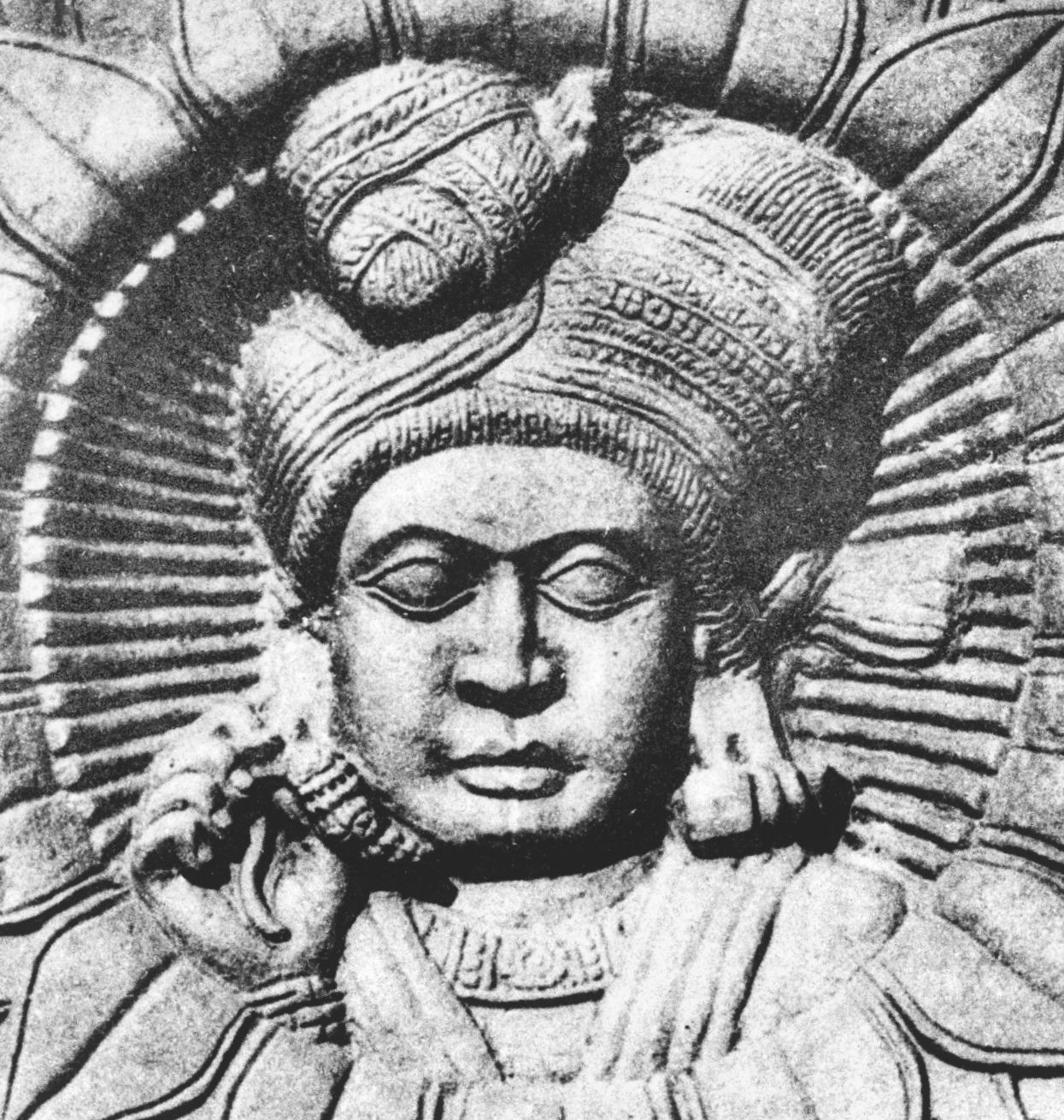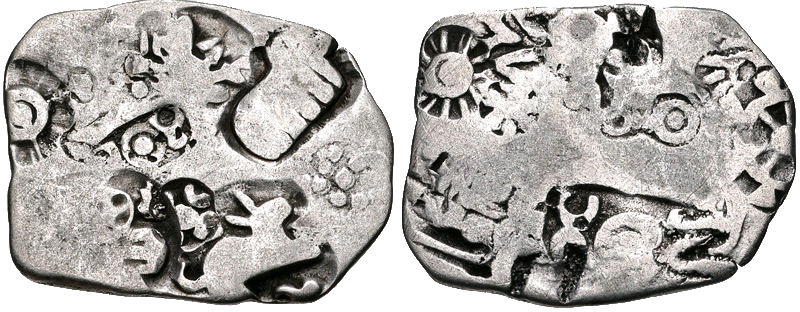|
Pataliputra
Pataliputra (IAST: ), adjacent to modern-day Patna, Bihar, was a city in ancient India, originally built by Magadha ruler Ajatashatru in 490 BCE, as a small fort () near the Ganges river.. Udayin laid the foundation of the city of Pataliputra at the confluence of two rivers, the Son and the Ganges. He shifted his capital from Rajgriha to Pataliputra due to the latter's central location in the empire. It became the capital of major powers in ancient India, such as the Shishunaga Empire (–345 BCE), Nanda Empire (), the Maurya Empire (–180 BCE), and the Pala Empire (–1200 CE). During the Maurya period (see below), it became one of the largest cities in the world. As per the Greek diplomat, traveler and historian Megasthenes, during the Mauryan Empire (–180 BCE) it was among the first cities in the world to have a highly efficient form of local self government. The location of the site was first identified in modern times in 1892 by Laurence Waddell, published a ... [...More Info...] [...Related Items...] OR: [Wikipedia] [Google] [Baidu] |
Patna
Patna (; , ISO 15919, ISO: ''Paṭanā''), historically known as Pataliputra, Pāṭaliputra, is the List of state and union territory capitals in India, capital and largest city of the state of Bihar in India. According to the United Nations, as of 2018, Patna had a population of 2.35 million, making it the List of cities in India by population, 19th largest city in India. Covering and over 2.5 million people, its urban agglomeration is the List of million-plus urban agglomerations in India, 18th largest in India. Patna also serves as the seat of Patna High Court. The Buddhist, Hindu and Jain pilgrimage centres of Vaishali district, Vaishali, Rajgir, Nalanda, Bodh Gaya and Pawapuri are nearby and Patna City is a sacred city for Sikhs as the tenth 10th Sikh Guru, Sikh Guru, Guru Gobind Singh was born here. The modern city of Patna is mainly on the southern bank of the river Ganges. The city also straddles the rivers Son River, Son, Gandak and Punpun River, Punpun. The city ... [...More Info...] [...Related Items...] OR: [Wikipedia] [Google] [Baidu] |
Maurya Empire
The Maurya Empire was a geographically extensive Iron Age historical power in South Asia with its power base in Magadha. Founded by Chandragupta Maurya around c. 320 BCE, it existed in loose-knit fashion until 185 BCE. The primary sources for the written records of the Mauryan times are partial records of the lost history of Megasthenes in Roman texts of several centuries later; the Edicts of Ashoka, which were first read in the modern era by James Prinsep after he had deciphered the Brahmi script, Brahmi and Kharoshthi script, Kharoshthi scripts in 1838; and the ''Arthashastra'', a work first discovered in the early 20th century,: "... another source that enjoyed high standing as a description of the early Mauryan state was the Arthashastra, a treatise on power discovered in the early twentieth century." and previously attributed to Chanakya, but now thought to be composed by multiple authors in the first centuries of the common era. Archaeologically, the period of Maury ... [...More Info...] [...Related Items...] OR: [Wikipedia] [Google] [Baidu] |
Shunga Dynasty
The Shunga Empire (IAST: ') was a ruling entity centred around Magadha and controlled most of the northern Indian subcontinent from around 187 to 75 BCE. The dynasty was established by Pushyamitra, after taking the throne of Magadha from the Mauryas. The Shunga empire's capital was Pataliputra, but later emperors such as Bhagabhadra also held court at Besnagar (modern Vidisha) in eastern Malwa. This dynasty is also responsible for successfully fighting and resisting the Greeks in Shunga–Greek War. Pushyamitra ruled for 36 years and was succeeded by his son Agnimitra. There were ten Shunga rulers. However, after the death of Agnimitra, the second king of the dynasty, the empire rapidly disintegrated:K.A. Nilkantha Shastri (1970)''A Comprehensive History of India: Volume 2'' p.108: "Soon after Agnimitra there was no 'Sunga empire'." inscriptions and coins indicate that much of northern and central India consisted of small kingdoms and city-states that were independent ... [...More Info...] [...Related Items...] OR: [Wikipedia] [Google] [Baidu] |
Nanda Empire
The Nanda Empire was a vast empire that governed in Magadha and Gangetic plains with an enormous geographical reach in 4th-century BCE northeastern India, with some accounts suggesting existence as far back as the 5th century BCE. The Nandas built on the successes of their Haryanka and Shaishunaga predecessors and instituted a more centralised administration. Ancient sources credit them with amassing great wealth, which was probably a result of the introduction of a new currency and taxation system. Ancient texts also suggest that the Nandas were unpopular among their subjects because of their low-status birth, excessive taxation, and general misconduct. The last Nanda king Dhana Nanda was overthrown by Chandragupta Maurya, founder of the Maurya Empire. Modern historians generally identify the ruler of the Gangaridai and the Prasii mentioned in ancient Greco-Roman accounts as a Nanda king. While describing Alexander the Great's invasion of Punjab (327–325 BCE), Greco-Ro ... [...More Info...] [...Related Items...] OR: [Wikipedia] [Google] [Baidu] |
Patna District
Patna district is one of the thirty-eight districts of Bihar state in eastern India. Patna, the capital of Bihar, is the district headquarters. The Patna district is a part of the Patna division. The Patna district is divided into 6 Subdivisions (Tehsils) i.e. Patna Sadar, Patna City, Barh, Masaurhi, Danapur and Paliganj. As of 2011, it is the most populous district of Bihar and the fifteenth most populous district in India. The revenue district of Patna comes under the jurisdiction of a District Collector (District Magistrate). The office of the Patna DM is in the Patna Collectorate. History Patna is one of the oldest continuously inhabited places in the world. Patna was founded in 490 BCE by the king of Magadha. Ancient Patna, known as Pataliputra, was the capital of the Magadha Empire under the Haryanka, Nanda, Mauryan, Shunga, Gupta and Pala empires. Pataliputra was a seat of learning and fine arts. Patliputra was home to many mathematicians, astronomers, ... [...More Info...] [...Related Items...] OR: [Wikipedia] [Google] [Baidu] |
List Of Largest Cities Throughout History
This article lists the largest human settlements in the world (by population) over time, as estimated by historians, from 7000 BC when the largest human settlement was a proto-city in the ancient Near East with a population of about 1,000–2,000 people, to the year 2000 when the largest human settlement was Tokyo with 26 million. Rome, Chang'an or Baghdad may have been the first city to have 1,000,000 people, as early as the 1st century or as late as the 8th century. Later cities that might have reached 1 million include Luoyang, Kaifeng, Hangzhou, Jinling, Beijing, and Edo. There is wide agreement that London was the first city to reach 2 million and New York City, New York was the first to reach 10 million. The Greater Tokyo Area has been the most populous metropolitan area in the world since 1955, with more than 37.393 million residents as of 2020. Jakarta is expected to overtake Tokyo by 2030, partly due to Tokyo's shrinking population. As disagreements between the so ... [...More Info...] [...Related Items...] OR: [Wikipedia] [Google] [Baidu] |
Udayin
Udayin (reigned -444 BCE or 373-357 BCE) also known as Udayabhadra was a king of Magadha in ancient India. According to the Buddhist and Jain accounts, he was the son and successor of the Haryanka king Ajatashatru. Udayin laid the foundation of the city of Pataliputra at the confluence of two rivers, the Son and the Ganges. He shifted his capital from Rajagriha to Pataliputra due to the latter's central location in the empire. Ancestry According to the Buddhist accounts, the successors of the Magadha ruler Bimbisara were Ajatashatru, Udayabhadra (Udayin), Anuruddha, Munda and Nagadasaka. The Jain tradition mentions Udayin as the son and successor of Ajatashatru. Kings Bimbisara (), Ajatashatru (–460 BCE), and Udayin (–440 BCE) of the Haryanka dynasty were patrons of Jainism. However, the Puranas name the successors of Bimbisara as Ajatashatru, Darshaka, Udayin, Nandivardhana and Mahanandin. The '' Matsya Purana'' names Vamsaka as the successor of Ajatashatru. Since t ... [...More Info...] [...Related Items...] OR: [Wikipedia] [Google] [Baidu] |
Laurence Waddell
Lieutenant Colonel Laurence Austine Waddell, CB, CIE, F.L.S., L.L.D, M.Ch., I.M.S. RAI, F.R.A.S (29 May 1854 – 19 September 1938) was a Scottish explorer, Professor of Tibetan, Professor of Chemistry and Pathology, Indian Army surgeon, collector in Tibet, and amateur archaeologist. Waddell also studied Sumerian and Sanskrit; he made various translations of seals and other inscriptions. His reputation as an Assyriologist gained little to no academic recognition and his books on the history of civilization have caused controversy. Some of his book publications however were popular with the public, and he is regarded by some today to have been a real-life precursor of the fictional character Indiana Jones. Life Laurence Waddell was born on 29 May 1854, and was the son of Rev. Thomas Clement Waddell, a Doctor of Divinity at Glasgow University and Jean Chapman, daughter of John Chapman of Banton, Stirlingshire.Thomas, 1939. Laurence Waddell obtained a bachelor's degree ... [...More Info...] [...Related Items...] OR: [Wikipedia] [Google] [Baidu] |
Pala Empire
The Pāla Empire was the empire ruled by the Pala dynasty, ("protector" in Sanskrit) a medieval Indian dynasty which ruled the kingdom of Gauda Kingdom, Gauda. The empire was founded with the election of Gopala, Gopāla by the chiefs of Kingdom of Gauda, Gauda in late eighth century CE. The Pala stronghold was located in Bengal and eastern Bihar, which included the major cities of Gauḍa (city), Gauḍa, Bikrampur, Vikramapura, Pataliputra, Pāṭaliputra, Munger, Monghyr, Somapura, Ramavati (Varendra), Tamralipta, Tāmralipta and Jaggadala, Jagaddala. The Pālas were astute diplomats and military conquerors. Their army was noted for its vast war elephant corps. Their navy performed both mercantile and defensive roles in the Bay of Bengal. At its zenith under emperors Dharmapala (emperor), Dharmapala and Devapala (Pala dynasty), Devapala in the early ninth century, the Pala empire was the dominant power in the northern Indian subcontinent, with its territory stretching across ... [...More Info...] [...Related Items...] OR: [Wikipedia] [Google] [Baidu] |
Shaishunaga Dynasty
The Shaishunaga dynasty (IAST: Śaiśunāga, literally "of Shishunaga") was possibly the second ruling dynasty of Magadha. According to the Buddhist text Mahavamsa, this dynasty was the second ruling dynasty of Magadha, succeeding Nagadashaka of the Haryanka dynasty. The Hindu ''Puranas'' have given a different list with different chronology of the Shaishunaga dynasty kings, whereas Jain texts do not mention this dynasty. History Shishunaga was the founder of the dynasty. He was initially an ''amatya'' or "minister" of the last Haryanka dynasty ruler Nāgadāsaka and ascended to the throne after a popular rebellion in . The capital of this dynasty initially was Vaishali; but later shifted to Pataliputra, near the present day Patna, during the reign of Kalashoka. According to tradition, Kalashoka was succeeded by his ten sons. This dynasty was succeeded by the Nanda dynasty in . Historicity Jain texts have skipped over the Shaishunaga dynasty. They mention instead that ... [...More Info...] [...Related Items...] OR: [Wikipedia] [Google] [Baidu] |






